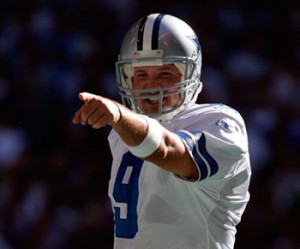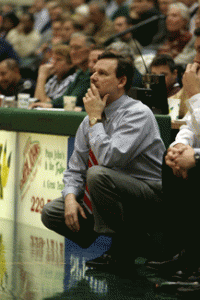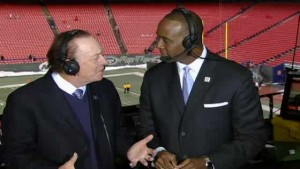Waiting for the Weekend: Paying Your Dues

Tony Romo has earned star status in the NFL despite being undrafted out of Eastern Illinois.
In this era when multi-million dollar contracts are often lavished on players and coaches who have done little to justify such riches, there are still examples out there of people who are enjoying success after paying their dues.
Below are the stories of a player, coach and a broadcaster who are all now enjoying the fruits of success after taking the tough road to glory.
Wearing The Star
There are some that think because Tony Romo is the quarterback of the Dallas Cowboys and received lots of recognition long before he won a playoff game that he has been handed success.
In reality, that perception couldn’t be further from the truth.
I would argue that there have been very few superstar quarterbacks in NFL history who have overcome as many obstacles to success as Romo.
Consider that of the eight quarterbacks still in the NFL Playoffs, four were selected in the first round of the NFL Draft, two were selected in the second round and the other two (Warner and Romo) were undrafted free agents.
Warner is the ultimate underdog story and his tale has been told many times over the last decade, but Romo’s rise from obscurity to stardom also deserves to be recognized.
A three-time Division I-AA All-American at Eastern Illinois (not generally recognized as an NFL hotbed), Romo went undrafted during the 2003 NFL Draft.

Signing as an undrafted free agent with the Dallas Cowboys, Romo spent three seasons in Dallas without even throwing a single pass.
Finally, in 2006 he replaced veteran Drew Bledsoe in the lineup midway through the season and led Dallas to the playoffs while earning a surprise trip to the Pro Bowl.
Unfortunately for Romo, his season ended with an unfortunate drop of a snap while holding for what would have been the game-winning field goal against the Seahawks.
The next season, he again earned a spot in the Pro Bowl while leading Dallas to a conference-best 13-3 overall record. However, the season again ended with a disappointing playoff loss and critics started to question whether Romo was worthy of his lofty status.
He didn’t silence the doubters in 2008 when the Cowboys failed to reach the postseason despite high expectations.
For a while, Romo was making more news off the field with his much-publicized relationship with Jessica Simpson.
Finally, in 2009 he returned to past form with his best statistical season. While his 26 touchdown passes fell short of his previous high of 36, he threw only nine interceptions and set career highs for passing yardage and quarterback rating.
Best of all, Romo led Dallas to their first winning December of his career and punctuated it with a great performance in their first playoff win in more than a decade.
Romo may now be a household name, but that glory was well earned through hard work and great perseverance.
Moving Up The Coaching Ladder
At a time when much publicity is given to a young coach like Lane Kiffin who has held almost as many jobs as he has produced wins, there are still stories out there of coaches who have worked their way through the system to enjoy success.

William & Mary basketball coach Tony Shaver spent 27 years as a high school and small college head coach before getting his chance at Division I.
Perhaps no coach embodies that determination more than current William & Mary head basketball coach Tony Shaver.
A one-time walk-on to the basketball team at the University of North Carolina, Shaver began his coaching career with a ten year stint as the coach at Episcopal High School in Virginia.
He then moved to Hampden-Sydney College, an all-male Division III school in Southern Virginia that was better known for its academic prowess than athletic success.
In 17 seasons, Shaver turned the Tigers into perennial conference champions and a national contender. He won 74% of his games and led H-SC to eight conference titles and 11 NCAA Tournament appearances.
He twice took the Tigers to the NCAA Final Four, including in 1999 when they reached the NCAA Division III title game.
In a classic contest, H-SC lost by one-point in double overtime to Wisconsin-Platteville. Ironically the coach for UW-Platteville was another coach who would eventually get a crack at Division I, current University of Wisconsin coach Bo Ryan.
After having interviewed for several Division I jobs, Shaver finally got his chance in 2003. Unfortunately, instead of coaching at a school with a strong basketball tradition, Shaver’s shot was at perennial basement dweller William & Mary.
Shaver inherited a program that had registered only two winning seasons in the previous 18 years. After winning only 23 games during his first three seasons, Shaver led the Tribe to a .500 record in 2007 and then a 17-16 record the following season for the school’s first back-to-back non-losing seasons in more than 20 years.
In addition, the Tribe made an improbable run to the finals of the 2008 Colonial Athletic Association tournament before losing to George Mason in the finals. Shaver was recognized as the CAA Coach of the Year in both 2007 and 2008.
But that seems to only have been the primer for Shaver and the Tribe.
This season, William & Mary is off to an impressive start with a 13-3 record, including a pair of road victories over ACC programs Wake Forest and Maryland. The Tribe will be looking to advance to the NCAA Tournament for the first time in school history.
Given the success of Shaver, Ryan and another former small college coach in Tennessee’s Bruce Pearl, it makes you wonder why major colleges seem reluctant to give coaches from Division II & III more opportunities to shine at the top level.
Every Game Is Important
With hundreds of sporting events now broadcast on television every month, there are many former athletes now earning a living as a color commentator. In many cases, they have earned a lofty perch not because of their prowess as a broadcaster, but instead because of their name recognition following a successful professional career.

Charles Davis (right) has worked his way up to become one of the top football commentators in the business.
Even in this setting there is still occasionally the story of a successful color commentator who earned a spot on network television not because of previous success, but because of hard work in perfecting his craft.
One such case is current NFL broadcaster Charles Davis.
A former college football player at the University of Tennessee, Davis went to training camp with the Dallas Cowboys, but didn’t make the team.
He then turned to private business while also investigating a career in broadcasting. Davis served as the director of the PGA Golf Tournament held at Walt Disney World while starting his broadcast career.
Among his initial opportunities was as the color commentator for Sunshine State Conference (NCAA-Division II) sports broadcasts. Davis announced basketball games, but also handled other sports.
I was the Sports Information Director at Rollins College while Davis was honing his craft and watched him broadcast a number of sports.
The key to being a great broadcaster is to treat every player, coach and game with respect and a level of importance, regardless of whether you are broadcasting Rollins College softball or the Bowl Championship Series National Title Game (as Davis did for three years).
His professionalism while broadcasting softball and other sports at the Division II level made it very clear that he would eventually move to the next level.
After spending three years as the lead college football analyst for Fox-Sports, Davis moved to the NFL this season and partnered with veteran announcer Dick Stockton. He also has done work for TBS, TNT, NFL Network and the Big Ten Network.
While many of the former NFL players come and go from the broadcast booth, you can bet that Davis will have a long career as a broadcaster because he isn’t in the booth because he has a name, he is in the booth because he has earned his place.
Birthdays
Each week we look at some current and former athletes who were born during the week. This week I also want to convey a special Happy Birthday to my youngest brother, Dale, who is currently serving as a Lieutenant Colonel in the U.S. Air Force and will be celebrating this birthday on January 16 while in Iraq.
Here are some notable sports figures born during this week:
January 15 – Mike Marshall (1943), Randy White (1953), Mary Pierce (1975)
January 16 – Guy Chamberlin (1894), Dizzy Dean (1911), Jack McDowell (1966), Roy Jones, Jr. (1969)
January 17 – Muhammad Ali (1942), Chili Davis (1960), Tyler Houston (1971)
January 18 – Joe Schmidt (1932), Brady Anderson (1964), Dwayne Carswell (1972)
January 19 – Dan Reeves (1944), Steve DeBerg (1954), Ottis Anderson (1957), Junior Seau (1969)
January 20 – Carol Heiss Jenkins (1940), John Naber (1956), Ozzie Guillen (1964), Terry Kirby (1970)
January 21 – Hakeem Olajuwon (1963), Detlef Schrempf (1964), Chris Hammond (1966)